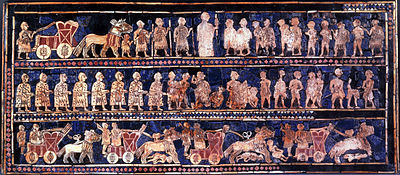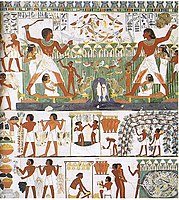User:Mdd/History of organization charting

The history of organization charting refers here to origins and development of the
The history of organization charting is divided here in an early history from the first civilisations up to the dawn of the
The intention of most of the earlier works have often remained unknown, and are open to reinterpretation. Historical studies in the graphic history of organization and organizational theory are rare, and scattered. There is a general understanding, that Daniel McCallum drew one of the earliest organizational charts in American business.[1] However, what happened before and after, is still quite unclear.
Early history
Picturing authority in the first civilisation
One of the earliest example of a societal structure depicted is the Standard of Ur, a hollow wooden box with scenes of war and peace from the ancient city of Ur from ca. 2.600 BC.
-
Standard of Ur, war side, c. 2600 BC
-
Standard of Ur, peace side, c. 2600 BC
From Ancient Egypt images have been found in which both daily life is picture, and the social structure of daily life. One of the most remarkable example are the images from the tomb of Nakht at Thebes from the 14th century B.C.[2]:
Nakht was an ancient Egyptian official, astronomer (Astronomer of Amun), scribe, and priest during the reign of Thutmose IV, during the Eighteenth Dynasty.
Organization charting in the Roman Empire
- System of Gods in the friezes of the Pantheon, the shrine of Alexander the Great
- Road maps and map of Rome
- Logical systems pictures in 8th century works.
The dawn of organization charting in the middle ages
Medieval examples of organizational structures depicted
-
Philip IV of France, 14th century
-
Organizational Structure of the Empire of the Holy Roman Empire inNuremberg Chronicle, 1493
-
Tuebinger Hausbuch Freie Kuenste, 15th century
-
Double-headed eagle with coats of arms of individual states, symbol of the Holy Roman Empire, 1510
The enlightenment and the charting of organization
Older example the Porphyrian tree
New the picturing of systems of plants, organism, knowledge
Modern history
The first modern organizational charts
Listing of first originals
Listing of first known charts where original principles have been are re-used
Organization charting in the later 19th century
Organization listing
Organization classification charts
First charts in the late 19th century
The breakthrough of the organizational chart
Study of organizational charts and its history
In the early 20th century there was a growing awareness of the usability of organizational charts for management, and the chart was published in a growing number of articles ever since. In 1905 a first two-page article was published, exclusively on organization chart by US Majoor Kendall Banning, entitled An Organization chart for builders.[3]
One of the first works to represent an organizational charts independently, was Willard C. Brinton in his 1914 book, Graphic methods for presenting facts. The first chapter devoted a few pages on this topic, with three illustrations and a couple of related diagrams.[4] The second edition from 1946 contained a separate chapter.[5] The 1922 book Graphic charts in business; how to make and use them by Allan Cecil Haskell contained a chapter about how organization charts art made, and a chapter on the organization chart. The seminal work in those days, Charts and graphs by Karl G. Karsten (1923) showed some organizational charts not in a separate chapter, but in a chapter on classification charts.
In his 1977
References
- The Visible Hand: The Managerial Revolution in American Business. p. 101
- ^ N. de Garis Davies The tomb of Nakht at Thebes. New York (1917).
- ^ Kendall Banning. "An Organization chart for builders," in: Arch Wilkinson Shaw, The Magazine of Business, Vol. 8, 1905, p. 623; Banning was Director of the Division of Pictures.
- ^ Willard C. Brinton, Graphic methods for presenting facts. 1914. p. 13-16
- ^ Brinton (1914/1946, 59-67)
External links
 Media related to Organizational chart at Wikimedia Commons
Media related to Organizational chart at Wikimedia Commons










